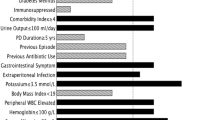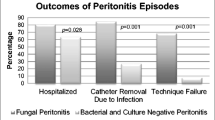Abstract
Background and aim
Fungal peritonitis is a rare but serious complication in patients undergoing peritoneal dialysis (PD). We aimed to analyze the predisposing factors, clinical aspects, etiological agents, and treatment of fungal peritonitis in patients with PD in our hospital.
Patients and methods
The data of all patients with PD, who were followed-up between January 1995 and December 2009, were evaluated retrospectively. Twenty-one patients with fungal peritonitis were included into the study.
Results
Mean age was 46 ± 13. Twelve of the 21 patients were females. Median PD duration was 48 (range 9 to 95) months. Candida species were the most common pathogens isolated from peritoneal effluent fluid (n: 16): Candida albicans (14), Candida rugosa (n: 1), and Candida glabrata (n: 1). The other involved fungi were Aspergillus species (n: 1), Saccharomyces species (n: 1), Acromonium species (n: 1), Fusarium species (n: 1), and Rhodotorula mucilaginosa (n: 1). The PD catheter was removed in all of the patients. Median time until the PD catheter removal was 1 (range 0 to 10) day. Before 2005, this duration was 4 (0–10) days, whereas after 2005 it was 0 (0–2) days (P: 0.001). Therapy with amphotericin B and fluconazole was continued after catheter removal in 19 and in 2 of the patients, respectively. As a result of fungal peritonitis, 19 patients were transferred to hemodialysis. Two patients died during the episode of peritonitis.
Conclusions
Candida albicans was the most common pathogen. For the successful management of fungal peritonitis besides the antifungal therapy, peritoneal catheter removal was necessary in all of the patients.
Similar content being viewed by others
References
Piraino B, Bailie GR, Bernardini J et al (2005) Peritoneal dialysis-related infections recommendations: 2005 update. Perit Dial Int 25:107–131
Kim BS, Choi HY, Ryu DR et al (2005) Clinical characteristics of dialysis related sclerosing encapsulating peritonitis: multi-center experience in Korea. Yonsei Med J 46:104–111
Zelenitsky S, Barns L, Findlay I et al (2000) Analysis of microbiological trends in peritoneal dialysis-related peritonitis from 1991 to 1998. Am J Kidney Dis 36:1009–1013
Wang AY, Yu AW, Li PK et al (2000) Factors predicting outcome of fungal peritonitis in peritoneal dialysis: analysis of a 9-year experience of fungal peritonitis in a single center. Am J Kidney Dis 36:1183–1192
García-Martos P, Gil de Sola F, Marín P et al (2009) Fungal peritonitis in ambulatory continuous peritoneal dialysis: description of 10 cases. Nefrologia 29:534–539
Indhumathi E, Chandrasekaran V, Jagadeswaran D et al (2009) The risk factors and outcome of fungal peritonitis in continuous ambulatory peritoneal dialysis patients. Indian J Med Microbiol 27:59–61
Oygar DD, Altiparmak MR, Murtezaoglu A et al (2009) Fungal peritonitis in peritoneal dialysis: risk factors and prognosis. Ren Fail 31:25–28
Bren A (1998) Fungal peritonitis in patients on continuous ambulatory peritoneal dialysis. Eur J Clin Microbiol Infect Dis 17:839–843
Bibashi E, Memmos D, Kokolina E et al (2003) Fungal peritonitis complicating peritoneal dialysis during an 11-year period: report of 46 cases. Clin Infect Dis 36:927–931
Keane WF, Bailie GR, Boeschoten E et al (2000) Adult peritoneal dialysis-related peritonitis treatment recommendations: 2000 update. Perit Dial Int 20:396–411
Matuszkiewicz-Rowinska J (2009) Update on fungal peritonitis and its treatment. Perit Dial Int 29(Suppl 2):S161–S165
Záruba K, Peters J, Jungbluth H (1991) Successful prophylaxis for fungal peritonitis in patients on continuous ambulatory peritoneal dialysis: six years’ experience. Am J Kidney Dis 17:43–46
Thodis E, Vas SI, Bargman JM et al (1998) Nystatin prophylaxis: its inability to prevent fungal peritonitis in patients on continuous ambulatory peritoneal dialysis. Perit Dial Int 18:583–589
Acknowledgments
The authors express thanks to Ayperi Eyupoglu, Handan Cakmak and Dudu Unal, who are PD nurses, for their contribution in patient care.
Author information
Authors and Affiliations
Corresponding author
Rights and permissions
About this article
Cite this article
Unal, A., Kocyigit, I., Sipahioglu, M.H. et al. Fungal peritonitis in peritoneal dialysis: an analysis of 21 cases. Int Urol Nephrol 43, 211–213 (2011). https://doi.org/10.1007/s11255-010-9763-2
Received:
Accepted:
Published:
Issue Date:
DOI: https://doi.org/10.1007/s11255-010-9763-2




